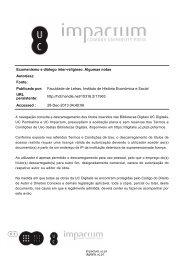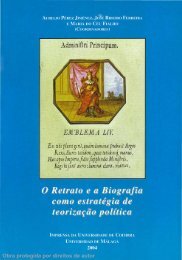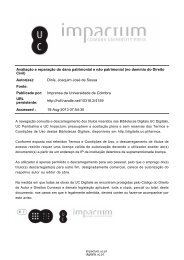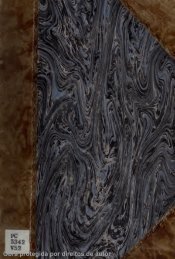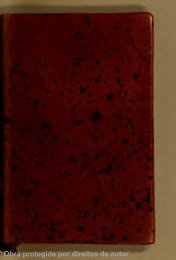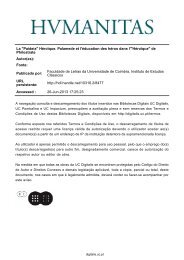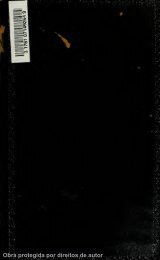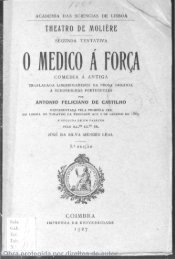O discurso acerca de los versos de Faria y Sousa no prólogo do ...
O discurso acerca de los versos de Faria y Sousa no prólogo do ...
O discurso acerca de los versos de Faria y Sousa no prólogo do ...
You also want an ePaper? Increase the reach of your titles
YUMPU automatically turns print PDFs into web optimized ePapers that Google loves.
O DISCuRSO ACERCA DE LOS VERSOS<br />
DE FARIA y SOuSA. NO PRóLOGO DO<br />
COmENTáRIO DAS RImAS VARIAS DE CAmõES<br />
MariMilda viTali<br />
Universida<strong>de</strong> <strong>de</strong> Coimbra<br />
Resumo<br />
Segun<strong>do</strong> o cronista catala<strong>no</strong> Antonio Beuter, o inventor <strong>do</strong> <strong>de</strong>cassílabo não<br />
foi um poeta da escola siciliana, mas sim Jordi <strong>de</strong> Sant Jordi. A esta mistificação,<br />
que se tornara bastante popular, <strong>Faria</strong> e <strong>Sousa</strong> substituiu outra, forjada pelo cronista<br />
Bernar<strong>do</strong> <strong>de</strong> Brito: já cerca <strong>de</strong> 1090 Gonçalo Hermigues, o ‘traga-Mouros’, teria<br />
composto alguns poemas em <strong>de</strong>cassílabos, <strong>de</strong>dica<strong>do</strong>s à sua amada Oureana.<br />
Na verda<strong>de</strong>, a ‘canção <strong>de</strong> Hemigues’ faz parte <strong>de</strong> um corpus <strong>de</strong> cinco poemas<br />
pretensamente antigos, compostos sob o rei<strong>no</strong> <strong>de</strong> Felipe II <strong>no</strong> intuito <strong>de</strong> e<strong>no</strong>brecer<br />
as orígens <strong>de</strong> Portugal. Traduzida por Almeida Garrett, a lenda <strong>de</strong> Hermigues foi<br />
logo objecto <strong>de</strong> uma longa controversia entre Teófilo Braga e Carolina Michaëlis.<br />
Palavras-chave: <strong>Faria</strong> e <strong>Sousa</strong> Rimas várias – origens <strong>do</strong> <strong>de</strong>cassílabo –<br />
Gonçalo Hermigues.<br />
Abstract<br />
Was the <strong>de</strong>casyllable really invented by a poet of the Sicilian school? According<br />
to the Catalan chronicler Antonio Beuter, it is Jordi <strong>de</strong> Sant Jordi who should rather<br />
be credited with the invention of this verse. For Beuter’s plain mystification, which<br />
nevertheless had become increasingly popular, <strong>Faria</strong> e <strong>Sousa</strong> managed to substitute a<br />
literary forgery found in Bernar<strong>do</strong> <strong>de</strong> Brito’s Chrónica <strong>de</strong> Cister. According to Brito’s<br />
version, Gonçalo Hermigues, the legendary hero styled ‘Traga-Mouros’, would have<br />
written around 1090 some <strong>de</strong>casyllabic lines <strong>de</strong>dicated to his beloved Oureana. In fact,<br />
that is one of the five apocryphal poems composed during Philip II’s reign with a view to<br />
dignifying the origins of Portugal. After Garrett’s poetic translation, that legend became<br />
the subject of a polemic exchange between Teófilo Braga and Carolina Michaëlis.<br />
Key-words: <strong>Faria</strong> e <strong>Sousa</strong> Rimas várias – origins of <strong>de</strong>cassílabo – Gonçalo<br />
Hermigues.<br />
Humanitas 62 (2010) 189-224



